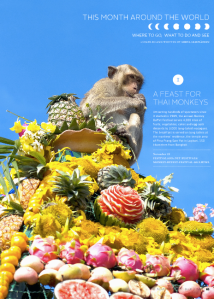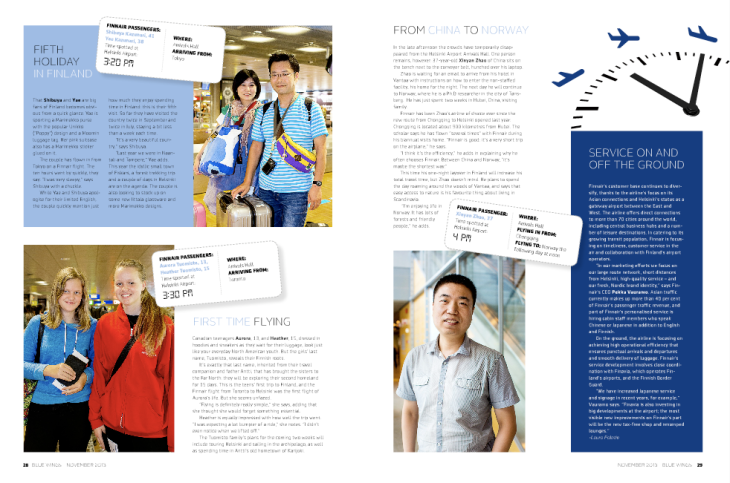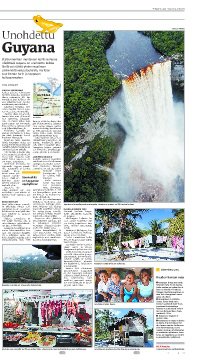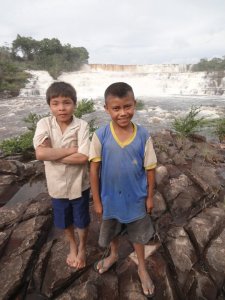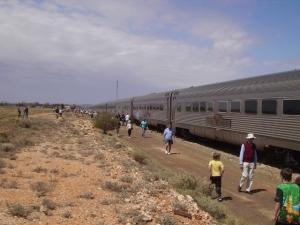Over the past four years Finnair’s in-flight magazine Blue Wings has been one of my main clients. I’ve written all kinds of articles for them, ranging from monthly travel news blurbs to longer features. Thus I thought I’d share one of my favorite articles that I have ever written for them. (To see the original layout, go here and scroll to page 20.) This is is about all the subway artists that are working so hard in the tunnels of New York, and are making commuting more fun for others in the process. 🙂 (And sure, there are always some people who are annoyed at these musicians and dancers as they bring noise to the subway car. But you can’t deny that some of these guys are crazy talented!)
Tag / travel writing
My Guadeloupe e-book is finally DONE!
It’s official! The Quick Gwada Guide e-book is finished! After six weeks of hard full-time work and a bucketload of joy and exhaustion … It’s finally done!! Yayyyyy. 🙂
If you are traveling to Guadeloupe with the new, cheap Norwegian flights from the US (or from elsewhere) and are interested in getting ideas for where to stay in Gwada, finding out the top 30 best things to see and do here, plus want to get answers to common traveler questions (What’s the seaweed situation like? Is it easy to find wifi? What should I bring with me? What if I don’t speak French?), this e-book is for you! It’s the first English-language guidebook about Guadeloupe written since the year 2000, so you literally cannot find more up-to-date information anywhere and in as concise of a format. (The e-book is 63 pages, but it’s easy to scroll to the sections that are most useful to you.)
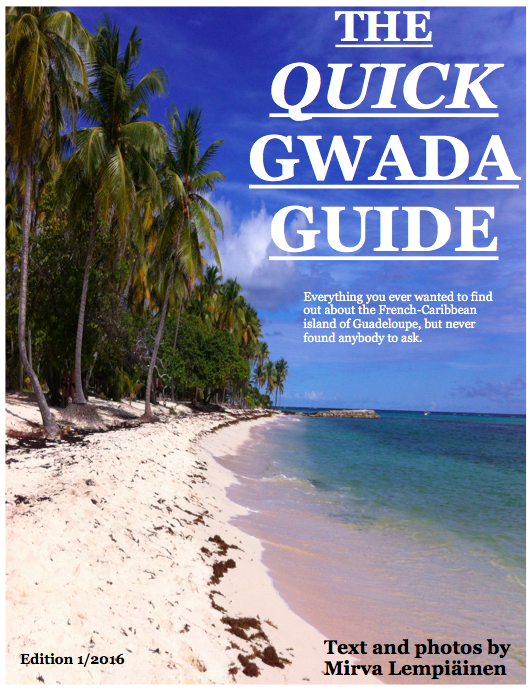
Here are some things that buyers have said about this e-book so far:
“I finished your book. It is absolutely excellent. This had to be a LOT of work for you, and I congratulate you on the result!” (Writer’s note: Yes, it was more work than I ever thought!)
“It is really, really good and I think it will be super helpful for first-time visitors! It would be really nice if Norwegian would put your guide in the seatbacks on all flights to Gwada!”
“Very helpful book. I will take the time to offer some feedback after returning from Guadeloupe.”
“I just wanted to thank you for all your guidance and friendliness. It contributed to a wonderful maiden journey to Guadeloupe!”
“Mirva, thanks so much for the guide. You are like the Rick Steves of Guadeloupe. If you publish your guide on Amazon or anywhere else, I’d be glad to give you a positive review.“
“Thank you so much! We got a lot of use out of your book.”
So yes, sounds like my guidebook has pretty much nailed it! And indeed, Amazon is the step I need to tackle next so that I can reach a bigger audience with this book. Another good contact could be the Guadeloupe tourist board and their new website. So much to do!
In the meantime, if you are interested in the Quick Gwada Guide, feel free to email me at gwadaguide@gmail.com to order a PDF copy. Based on reader reviews, it prints without any issues and can easily be read at least on the Amazon Kindle Fire.
The price of this e-book is $15 (thus a mere 23 cents per page!) and you will definitely save that money several times over if you invest in this guide. After all, I’m a budget traveler myself so I’ve included tons of tips for saving money while in Gwada, as well as a list of the top things to do here, many of them free or low-cost.
Payment is easiest done via Venmo or Paypal, using the email address of gwadaguide@gmail.com, but we can discuss other ways to pay if you aren’t familiar with those. Please leave your email address as a comment when you make the payment, so that I’ll know who to send the e-book to!
SEE YOU IN GUADELOUPE!

Christmas in Guadeloupe
Believe it nor, Christmas is just around the corner again (for those who celebrate it). For me that has traditionally meant one of two things: either I’m in my native Finland for Christmas, or I’m skipping the holiday altogether in favor of traveling.
Well, last year I assumed I would be skipping Christmas as I was spending the winter in the tropics, on my new adopted Caribbean home island of Guadeloupe. Being far from snow and Santa’s homeland (which is the Finnish Lapland of course), I figured there wouldn’t be a whole lot going on in terms of the festive season’s celebrations. But boy was I wrong! It turns out that Gwada folks love Christmas more than I ever could have imagined, and I ended up getting totally swept up by the celebrations, whether it was massive Chanté Nwel concerts or traditional Christmas markets. I loved it!
That said, here’s my article from the latest Blue Wings magazine on what to expect if you find yourself in the French Caribbean for Christmas (also available here in an online version when you scroll to pages 45-46):

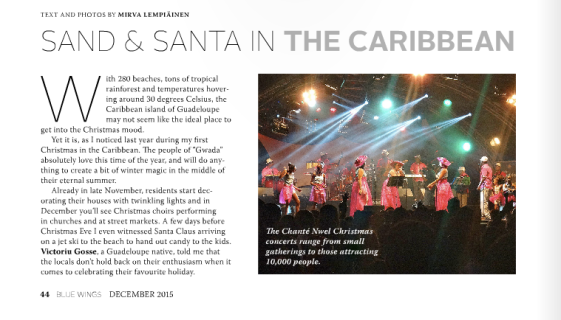

If you are interested in hearing what that “fast reggae-style” version of Silent Night sounds like, check out this video from a small Chanté Nwel concert in Guadeloupe. (The music starts after the 40-second a cappella part.) Catchy, eh?
What about you – have you ever gotten into the Christmas mood in an unlikely place? What’s your favorite Christmas destination?
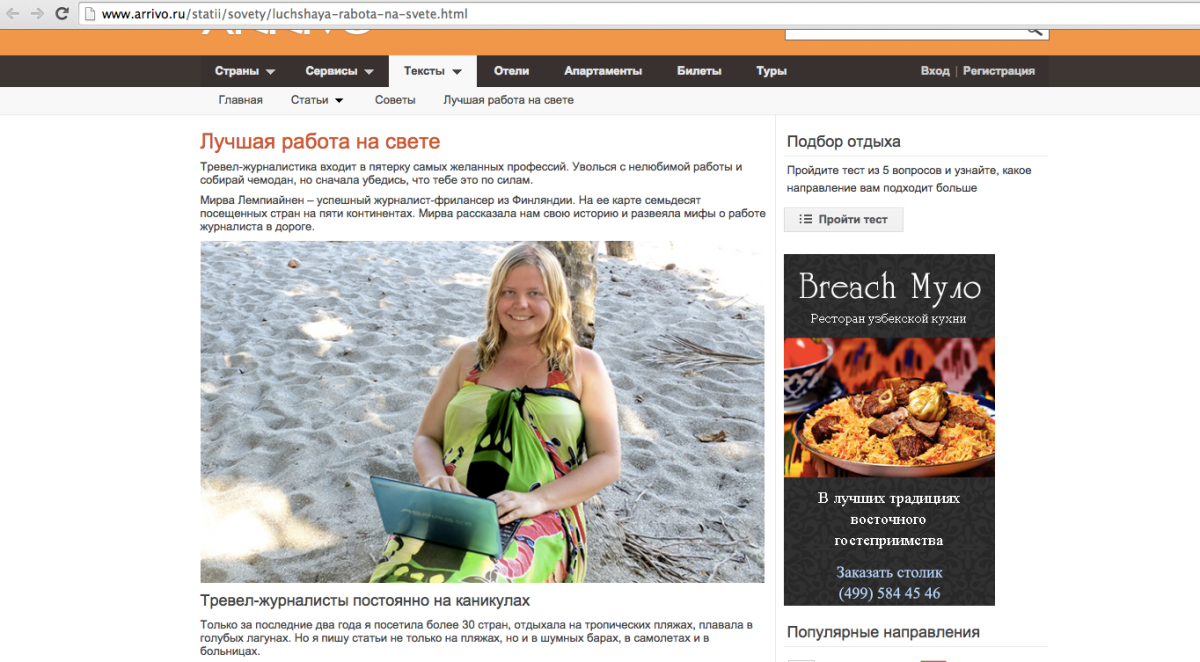
My Big Russian Media Debut!
Check this out – I’m famous in Russia! Woohoo!
Okay, well maybe not that famous, but at least a little bit – a translated version of my article about travel writing was published today in a Russian travel website called Arrivo. Apparently the website gets about one million unique visitors a month, so not too shabby! I would guess that’s just a few more than what my blog gets. 😉
You can get a general idea of the gist of the article if you read it with Google Chrome, as the browser does an automatic translation.
Or better yet, you can read the original English-language version here, as the article was first published by 219 Magazine, a publication of my alma mater, the CUNY Graduate School of Journalism.
For those of you that can read Russian, you’ll notice that the English version is organized slightly differently. In the words of the translator, Ivan Kuznetsov, “It’s not a word-to-word translation, but that way it sounds better in Russian. We changed it a bit: made it shorter, mixed myths and truths and your personal story, which was originally in the beginning, as your quotes.”
And how did I get to be published in Russia? Easy. All I did was host Ivan, a Russian guy, through Couchsurfing.com in Finland for one night back in the summer of 2012.
Ivan recently emailed me that he was on the path to becoming a travel writer himself, partly due to being inspired by my example! And he asked if he could translate this article of mine for Arrivo, one of his clients.
Those of you that speak Russian can learn more about Ivan from his traveler profile, also published on Arrivo. He also has a personal blog that is partly in English: www.kunavithewriter.com.
And here’s a picture of me and some friends with Ivan (who is wearing glasses) from his trip to Finland in 2012, when we went to visit the eco-village of Livonsaari near Turku. That was a fun day and we definitely saw some alternative ways of living – including a family with young kids that was happy to have no running water. They just bathed with buckets in order to save water and eventually the planet. That sounds all fine and dandy in the summer time, but the Finnish winters can be pretty harsh! Brrrr. But of course they had a sauna that makes it slightly better…
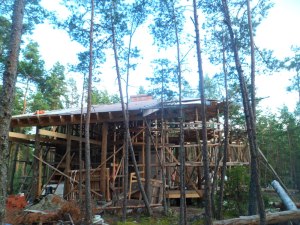 There was another woman building a giant wooden house for herself in the forest, after being tired of living in a “kota” for three summers – kota is a Finnish teepee of sorts. And there was another lady building a house with huge windows that allow in as much sunlight as possible.
There was another woman building a giant wooden house for herself in the forest, after being tired of living in a “kota” for three summers – kota is a Finnish teepee of sorts. And there was another lady building a house with huge windows that allow in as much sunlight as possible.
Speaking of alternative life choices: It turns out that Ivan’s life totally turned around after this visit to Turku and the eco-village! Though not in the way you would expect (nope, he didn’t move to the woods to be a hippie). Instead Ivan met a Polish guy at the eco-village who told him about the European Voluntary Service (EVS) program and he decided to apply for the program himself.
Here’s what Ivan wrote to me a year later from Italy:
“I would like to thank you very much for this unexpected tour to this village.I mean, this day in Turku with you and your friends really changed my life. My main goal was Stockholm, it was cool, but nothing amazing happened there. Turku was on the way to Helsinki, but many things happened.
The story behind is that after this day in Turku I thought about my life for the rest of the summer. I decided to quit my office job, my rental apartment in Saint Petersburg which I never really liked, and go for traveling. While applying for the EVS I discovered many new things and possibilities for budget travels, like Help Exchange and WWOOF, and many others.
Now I am a volunteer in an environmental education center in a small city or better to say a village – Lamon, in Dolomites mountains, about 100 km from Venice. We do workshops for kids, learn local nature, meet local people, learn Italian and just have a lot of fun. The place is very beautiful. Mountains around. I have never been in such a nice place. I love Italy very much. We already visited south of the country – Napoli (which is just a crazy city, in some ways even more crazy than New York!) and we are planning to go to Toscana the next weekend.
After the EVS I am planning to go to South America for at least one more year to travel, to learn Spanish and to collect material for my new book. Actually, my new book is writing itself just here in Italy. But this is only the beginning! Okay, it going to be a long letter. I just want to wish you good luck, to send a picture from my window now and to say that I miss Finland, north, nature and people very much.”
Here’s the picture he sent me. Not a bad outcome for a night of Couchsurfing in Turku! And cool that it lead to my Russian media debut as well. Life can be pretty surprising sometimes. 🙂
Want to be a travel writer?
Are you an aspiring travel writer or would you just like to know what life is like when the whole world is your office? Click here to read the article I wrote about the ins and outs of travel writing for 219 Magazine, published by my alma mater CUNY (The City University of New York Graduate School of Journalism).
The article can also be read in a different format on Medium.com.
Hope you like it and find it useful!
Happy 90th birthday, Finnair!
Finnair, the trusty airline of my home country, is celebrating a big birthday this year. Only 10 years to go until the BIG 100! Woohoo! 🙂 In January Finnair was named the world’s safest airline in 2012.
While just five years ago I didn’t have any particular ties to Finnair, nowadays I have quite a lot: in 2011, I was selected as one of the seven Quality Hunters bloggers traveling on Finnair for seven weeks. That gig saw me zoom from New York to Europe, Japan and India in my own personal record speed. I also now have a couple of friends who work at Finnair as flight attendants.
In addition, I’m a frequent contributor to Blue Wings, Finnair’s in-flight magazine, where I’m currently in charge of compiling the monthly calendar of events. So if you are flying with blue and white wings anytime soon, check out my event recommendations under the “This Month Around the World” pages. My favorite event for this month is the breakfast buffet festival for monkeys in Lopburi, Thailand. Would love to check it out one day. 🙂
With all these Finnair connections I’ve got going on, it was only suitable that Blue Wings asked me to write an article about Finnair’s 90th birthday – but to do it from the perspective of the passengers. Without the passengers, there would be no Finnair. So back in July I spent a day at the Helsinki Airport interviewing families and individuals for the story (and visiting the Book Swap that I helped create!). The point of the article was to show who flies with Finland’s national airline, and what they think about it.
Though I had to get up super early to get to the airport by the time the 6 a.m. rush starts, it was a really fun day of reporting. I was roaming around the airport together with photographer Tuomas Kolehmainen and our Finnair liason Markku Remes. Markku and I worked together during the Quality Hunters project too, so it was nice to catch up again. We met tons of interesting people, from international business men to Croatia’s official athletic team and Finland-loving Japanese tourists.
And here’s the result! The article is a pretty cool-looking three-page spread in the November issue of Blue Wings that is just now hitting the seat-back pockets of every Finnair flight from Hong Kong to New York. So if you are flying with the airline this month, keep an eye out for my story and my calendar. You can also read the latest issue online here (scroll to pages 24-25 for the birthday story that is pasted below, and to pages 64-65 for the start of my events listings. Just so you know – “sivu” means page in Finnish.). Hope you like reading the story as much as I liked reporting it!
Have you flown with Finnair? What was your experience like?
A case study of Guyana: When a country just feels right
If you have been keeping up with me on Facebook or Twitter (@mirva08), you may have noticed I’m currently in Nicaragua, my country number 62. After a brief 10-day stint in Costa Rica, I’ve now spent about five weeks exploring the “Unique and Original” Nicaragua, as the tourism authority’s new slogan goes. My friend Mira and I even managed to get ourselves featured in a local online magazine promoting Big Corn Island as a tourist destination. See how cozy I look in that hammock?
Being back on the Central American isthmus has got me thinking about quite a few things – including the last time I was here on these latitudes, in 2011. Back then I did a 3-month tour of the Caribbean and Central America, starting from the wild carnival in Trinidad and Tobago (which is actually going on right now!), and continuing onto Guyana, Jamaica, Cuba, Mexico, Belize and Guatemala.
While I had some fun times in all of those countries, I felt a closer connection with only a couple of them. I have since then wondered many times why some places “click” with you so well and just feel right, while others don’t.
That brings me to a case in point – Guyana. This is a country that made a lasting impact on me and was definitely a place I was sad to leave behind. To see the beauty of this land, check out the photos of this “Forgotten Guyana” article I wrote for Helsingin Sanomat (and if you are not Finnish-challenged, you can even read the article here):
I first became intrigued by Guyana when I traveled around South America in 2008. At some point during my 5-month trip I looked at the map and saw this relatively small country next to Venezuela that I realized I knew nothing about! I asked other travelers I met along the way if they had been to Guyana, or were planning on going. The answer was always no.
Nobody seemed to know anything about this place, and even the Lonely Planet has no guidebook for the country. It was obvious that I needed to go check out whether Guyana actually exists and what goes on there.
My opportunity to visit came up pretty unexpectedly in 2011. Once carnival in Trinidad was over, I was trying to figure out where to continue next. I then noticed that I could buy a one-way ticket from Port of Spain to Georgetown, Guyana’s capital, for $160 on Caribbean Airlines. Not bad! I found the ticket at 10 p.m. and the departure was at 6 a.m. the next day. I figured that if I skipped sleep for that night, I could do laundry, pack up my bags and be ready to head for the airport at 4 a.m. Sold!
As soon as I boarded the one-hour flight from Trinidad to Guyana, I knew I had stepped off the beaten path. The plane was only about a third full. Most people on the plane seemed to be locals, and were of Indian descent. Some 60 percent of Guyanese people, I later learned, have their roots in East India. Their ancestors were brought to Guyana as indentured servants back in the 1800’s when the English ruled the country. The rest of the Guyanese people are a mix of black people (40 percent), white folks, Native Americans (called Amerindians there) and something in between. Guyana is the only English-speaking country in South America, though the English there is of the Caribbean variety and very hard to understand (at least for me…).
On the plane I struck up conversation with a Guyanese man living in Canada, and got lots of good advice on where to go and what to do. He also offered to give me a ride to the center of Georgetown as his wife was about to pick him up at the airport. Sweet!
Much to my dismay, my arrival into the country wasn’t as smooth as I had hoped for. Having bought my ticket at such short notice, I didn’t have a plane ticket out of Guyana yet. And I didn’t know if I even wanted to buy one, as the man on the plane had told me I could take a bus to Suriname or to Brazil, and go from there to Venezuela.
But Guyanese immigration officials didn’t think that I should have the luxury of deciding my travel route on a later date. The serious and strict-looking ladies told me that I had to buy a ticket out of the country right then and there, or I was going to be flown back to Trinidad & Tobago. Blaah. Where’s your carnival spirit, people?
With immigration officials giving me a bad first impression of the country, I quickly decided to just stay for 8 days. I figured that if Guyana was as unwelcoming as its immigration officials, I didn’t want to waste too many of my precious travel days there. So on a whim, I bought a $300 ticket to Jamaica for the following week (a semi-random choice: I was heading to Cuba and figured that Jamaica was on the way).
After finally clearing customs I was lucky enough to run into the man from the plane who had offered me a ride to town. He was still waiting for his wife to come pick him up. That was great news for me, because it turned out my ATM card didn’t work in the airport’s cash machine and I couldn’t get any cash out (always a nice feeling in a foreign country, eh!). Catching a cab to the center of Georgetown would have thus been a challenge.
So my week in Guyana started with the friendly couple dropping me off at Hotel Tropicana in the center of Georgetown, and it ended up being quite an interesting eight days. The time actually felt more like three weeks, and included a lot of highs and lows.
The lows were mostly due to feeling pretty lonely at times: it turned out I was the only guest at my hotel and that there were barely any other travelers in the whole country. Guyana receives only about 100,000 international visitors per year (compared with Jamaica’s 600,000), and of those only 5 percent are coming strictly for tourism purposes. The great majority come for business conferences, to do volunteer work with NGOs or to visit family or friends. Thus I got stared at a whole lot wherever I went, whether it was onboard a river boat crossing the Essequibo, South America’s third largest river, or visiting the local market in Georgetown.
Walking around Georgetown and looking at the white wooden Victorian houses, surprisingly many of which were beautifully renovated, I felt like I had been tossed back to the 1800s. I was in this country that everyone had forgotten existed. There were at times more donkeys on the street than people. No wonder I had never met anybody that had traveled to Guyana. The place was empty! At least this was the case on a Sunday afternoon. On Monday the city’s pace picked up a bit, but it was by no means a buzzing metropolis.
The highlights of the week were plentiful, though. Through some contacts from the traveler’s networking site Couchsurfing.org I got to know plenty of locals, and got to witness a Hindu ceremony and an Indian wake (referring to the night before a funeral. The deceased person’s friends all get together to eat, chat and play Dominos).
Some of my new pals organized for us to go visit an Amerindian village nearby Lake Mashabo, which was an incredibly beautiful lake with palm trees growing out of it! I couldn’t believe my eyes. Can trees grow out of water? I hadn’t thought so… And later on I heard it was actually an artificial lake and that the trees were dying little by little. Boohoo.
Over the week I got invited to stay in local houses in the town of Bartica and the Essequibo Coast and tried various traditional Guyanese-Indian foods. My favorite was smashed pumpkin with roti, the fluffy Indian flatbread. I also tasted some really tasty chicken curry. One of my favorite meals was lunch at Coalpot, a small restaurant in Georgetown where you could pick and choose your favorites from a selection of Indian and African dishes, with mashed potatoes and macaroni pie thrown into the mix. The total price for the meal came to about $4.
Overall Guyana isn’t a cheap traveling country though, even if it is the poorest in South America: accommodation starts from $15-20 for a basic room. But considering all the offers I had to stay with my new local friends, the price of accommodation wasn’t really an issue. A bigger problem was the price of doing excursions and sightseeing. Now THAT is expensive in Guyana, mostly because there aren’t that many tourists and thus there’s no competition between travel agencies. Day trips to the Amerindian villages and nearby monasteries start at $150 per person, and a tour to the Kaieteur waterfall, one of the world’s biggest single-drop waterfalls, costs a minimum of $195. That’s because it’s located in the middle of the country in the dense tropical rainforest, and you have to fly there on a small plane. Going by land would mean driving a couple of days on bumpy roads, and then trekking for three days through the woods.
Since seeing Kaieteur was one of my biggest incentives for traveling to Guyana, I decided to splurge on the plane ride. But I soon found out that the price of the trip wasn’t the only problem: another one was the scheduling of it. None of the tour companies knew whether they’d have a trip going all week. It would all depend on whether other tourist would show up and sign up for the flight. Considering I hadn’t seen any other travelers during my time in Georgetown, I didn’t have high hopes of this happening.
In the end they did get a group of 9 together (comprised of people working with NGOs or visiting friends in the country), but it wasn’t until my last day in Guyana and the price was $270 instead of $195. This was because the tour also included a visit to another smaller waterfall in Southern Guyana, near the border of Brazil.
I decided to go for it anyway, even though this meant largely missing out on the colorful Indian Holi celebrations that were the same day (or Phagwa, as it’s called in Guyana). And I’m super happy that I went for it! It just might have been the best $270 I ever spent.
The whole day was pretty surreal, but the most amazing sight was flying over the solid green rainforest for an hour and suddenly seeing the huge Kaieteur waterfall pop up in middle of it all.
Our little 10-seater plane (where I got to be the co-pilot!) circled above it for a few minutes, and we could see the masses of water falling down to the bottom of the valley far underneath. Whoa! The drop is a whopping 7000 feet. Venezuela’s Angel Falls is of course higher, but that one is actually several waterfalls falling down simultaneously on top of one another. So as far as single waterfalls go, Kaieteur is the king. We landed on its tiny airstrip and went to admire it from several viewpoints.
Next we flew to visit (and to take a shower in!) the other more humble waterfall, Oruinduik, near the border of Brazil. There we got to meet some Amerindian kids. Apparently they always paddle over from the Brazilian side by kayaks when they see a small plane like ours arriving (which the guide said happens about once a week. Kaieteur gets more visitors than that, but most people don’t bother paying for the Oruinduik leg of the trip). The kids come over mostly for the joy of seeing some new faces in their isolated surroundings, but also in hopes of candy, food or some change. There were about six or seven kids, along with an older woman who was holding a baby. They stared at us in a shy but friendly manner. The girls all had long black hair, one of the boys had almond-shaped eyes. All had small holes and stains in their clothes, but were otherwise looking pretty sharp considering they live hours away from the nearest big town.
I took some photos of the kids and gave them some small bills for a couple of US dollars’ worth. Not knowing if they understood English, I slowly asked one of them “what-is- your-name?” He quickly answered with the confidence of an army soldier: “Kevin! Kevin Peter!”
So go figure. Even a Native American child who lives hundreds of miles from civilization has a name much easier than mine. Hah! 🙂
Needless to say, my time in Guyana was truly memorable and still brings a smile on my face. After just a few days there, I could tell this was a place where I felt right at home, though it looks nothing like my home country on the outside. There’s just something about Guyana that clicked with me.
Do you remember visiting a country that just felt right to you? What do you think it was that made you feel this way?
World’s Longest Train Rides: Trans Siberian vs. Indian Pacific
In case you were wondering whether the earth swallowed me last fall due to the radio silence on the blog, it kind of did: I spent much of September and October on the train crossing Russia, Mongolia and China. (See, I do get away from beach destinations sometimes!)
I had been planning on riding the Trans-Siberian railroad for years, as I’m a big fan of long train journeys. Yet for some reason I never got around to it before 2012. But it’s good that I didn’t – now I was able do the trip with my dad, who retired from the Finnish army a couple of years ago at the age of 50, and thus is a young senior citizen with plenty of free time. What better place to head for a family trip than Siberia!?
So after I spent a fun summer in Finland, my dad and I set off for the 3.5-week train journey into dark Siberia (which, funnily enough, ended up being bright and sunny the whole time). And just FYI: Most of this time was spent seeing sights and visiting towns along the way, not just sitting on the train. The actual travel time from Helsinki to Beijing was about a week.
After successfully completing the famous ride, I wrote an article for the Finnish newspaper Helsingin Sanomat, comparing the Trans-Siberian with another long train trip I’ve got under my belt, the Indian Pacific of Australia. (And yes, I know that by veering off to Mongolia after Ulan-Ude we actually took the Trans-Mongolian route for half of the trip, but for the purposes of the article, I focused on the Trans-Siberian part of the journey.)
The article turned out to be quite popular based on the feedback I heard, so I thought I’d do an English translation of it for you. So here we go:
The World’s Longest Train Rides
Which marathon train trip suits you better, the tundra-crossing Trans-Siberian or the Indian Pacific zooming by the desert? HS put the trips to the test.
The Trans-Siberian railway from Moscow to Vladivostok is 9, 259 kilometers long. The trip takes about 150 hours, or more than six days.
History: Building a railroad crossing Russia took 25 years. The constructions were completed in 1904, and involved 90 000 people. The majority were inmates and soldiers sentenced into manual labor.
The main attractions: The city of Nizhny Novgorod that was closed off from foreigners during the Soviet era, where the Volga River can be crossed with a cable car, the Perm region with its 10,000-year-old permafrost ice caves, the world’s deepest lake Baikal, Irkutsk with its wooden mansions and the Buryatian Republic‘s capital city Ulan-Ude.
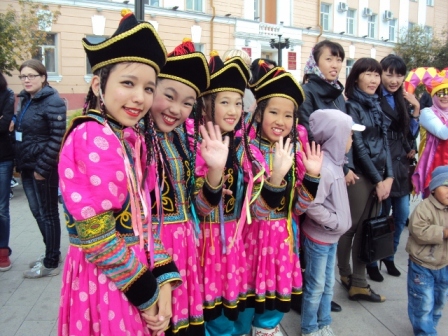
 The atmosphere: The train rattles steadily along the tracks. The tobacco smoke floating into the carriage adds to the sleepy atmosphere. A young man pours hot water into his ready-made mashed potatoes, a grandpa takes secret sips from his spiced-up Sprite bottle in between card games. In roadside towns, older grannies with headscarves sell greasy pelmenis. The nights go by while listening to the snores of your carriage mates, and wondering what the sudden stops are all about.
The atmosphere: The train rattles steadily along the tracks. The tobacco smoke floating into the carriage adds to the sleepy atmosphere. A young man pours hot water into his ready-made mashed potatoes, a grandpa takes secret sips from his spiced-up Sprite bottle in between card games. In roadside towns, older grannies with headscarves sell greasy pelmenis. The nights go by while listening to the snores of your carriage mates, and wondering what the sudden stops are all about.
Scenery: The landscape consists of Siberian birch forests, low hills, pine trees of the taiga and snow-capped mountains in the East. Pastel-colored houses and slowly crumbling old villages dot the way.
Travel companions: Despite the Trans-Siberian’s great international popularity, the majority of the passengers are Russians: retired couples, families returning from visiting relatives, army boys and sports teams on trips. Every now and then you can hear some conversations in the Buryat language, spoken by the Buryat people who are descendants of Mongolians. Of the foreigners, most are Chinese and European.
Price: For the 54-bed open carriage (platskarny), a one-way ticket costs about 200 euros. First and second class four-person cabins cost 400-1,000 euro per person, depending on the train. Tickets can be bought either in Finland or for slightly cheaper in the Russian railway stations.
Facilities: The first-class cabins have showers, other passengers have to make do with shared toilets. The dining car’s golden décor reminds you of the grandeur of days gone by with its silk table cloths and curtains. Beer and vodka flow freely, and chatter is accompanied by borscht soup.
Please note: The term “Trans-Siberian” refers to the train track crossing Russia, not to any particular “Trans-Siberian train.” Rossija and Baikal are some of the better-quality trains that serve the route, as well as the new British luxury train Golden Eagle Trans-Siberian Express. There are also local trains traveling between different Siberian towns. One option is to get off the train in the morning in a town of your choosing and to continue the journey in the evening with another train. In doing so, the tickets need to be bought separately for each leg of the journey. Pay attention to the departure times: Russian railways always operate in Moscow-time, no matter what the local time in your Siberian destination may be.
The Indian-Pacific travels from Sydney to Perth. The 4 352-kilometer train journey takes 65 hours, or three days.
History: The railroad that crosses Australia, connecting the Pacific and Indian Oceans, was opened in 1970. It includes the world’s longest straight piece of track, the 478-kilometer Nullarbor Plain.
The main attractions: Australia’s oldest mining town Broken Hill, the city of 700 churches known as Adelaide, Kalgoorlie with 100 years’ worth of gold fever history, Nullarbor Plain, the ghost village of Cook with its four residents and millions of flies, the beaches of Perth.
Atmosphere: The 700-meter row of metal wagons rummages through the desert, past the occasional kangaroo, emu, herds of camels and two-meter wedge-tailed eagles. Happy chatter fills the restaurant car as the chicken curry dishes are scarfed down from the tables seating four people. The atmosphere is communal. The vast emptiness behind the windows is highlighted as the radio blasts bits of Slim Dusty’s perky song every couple of hours: “The Indian Pacific spans the land!” One can’t help but join in on the tune. A train trip doesn’t get more Australian than this.
Scenery: The majority of the three-day trip is characterized by typical Australian landscape – red sandy desert, scrubs, bright orange sunsets and sunrises. Upon leaving Sydney you’ll see the bluish spruce-covered Blue Mountains, after Adelaide the shallow reddish mountains and on arrival to Perth, the lush Avon Valley.
Travel companions: Adventure-loving Australian retirees, locals moving across the country, European and North American backpackers and train travel enthusiasts.
Price: In the Gold Kangaroo section, a one-way trip in a luxury cabin with full board costs about 1,760 euro and in the Red Kangaroo section the same goes for 1,200 euros. Occasionally there will be platinum-level suites with a double bed on offer, costing 5,000 per person. Budget travelers have to settle for a reclining seat, best accessed by accruing a Rail Explorer pass. For about 360 euro you can ride Australian trains for three months.
Facilities: The Gold Kangaroo cabins feature bunk beds, combined toilet-shower stalls and large windows, and some come with a TV and minibar. Once the train has left the station, the Rail Explorer pass holders have the opportunity to purchase a Red Kangaroo cabin for 120 euro, provided there is enough room. Different travel classes have their own restaurant and lounge cars.
Please note: The stopovers are a few hours long. Guided city tours are sold for about 20 euro.
So that’s it! Have any of you taken the Trans-Siberian and/or the Indian Pacific? Any thoughts on which one is the best marathon train journey? 🙂
My article about Morocco in Helsingin Sanomat
Yesterday my first article that I reported from the African continent was published in Finland. It’s a hotel review of sorts that I wrote for Helsingin Sanomat, Finland’s largest newspaper (that I modestly like to call “our New York Times“). I contribute pretty frequently for the travel section of HS, often about New York but sometimes about other places around the world as well.
This most recent article was part of a series called “A One Night Test”, where the writer spends a night in a unique hotel and reviews the experience. I wrote about the dreamy desert oasis hotel of Ait Isfoul in Morocco, where I actually spent a whole week, as you may remember reading earlier. This was not a story that I pitched myself, but instead one of my editors read my blog post and thought that a write-up of this sand castle would fit well within the “One Night Test” series. And here’s the result:
Unfortunately the print is tiny so it’s impossible to read the article online, and it is also in Finnish, which might be a small problem for some of you. 🙂
But since the article is not too long, I quickly did a rough translation of it for you. Those of you that prefer to read it in Finnish can find the original Finnish version pasted after the English one.
So here you go:
In the sand castle hotel, you’ll even be dreaming of sand
MOROCCO. Even in the pitch-black darkness you notice it. The hotel is like a carefully crafted sandcastle.
The fine sand of the Sahara crunches under our feet and smells in the air when we step out of the desert hotel owner’s black BMW. Millions of stars shine above us – the sky is even brighter than in Finland in the dead of winter. The temperature has gone down to zero. (I’m talking about Celcius here – that is -32 Fahrenheit.)
The main building’s high towers poking in the sky are reminiscent of the palace in Nintendo’s Mario Brothers game where the evil demon is holding the princess hostage. But here it’s not a princess who is held in captivity, but a price of sorts. Kamal Yassine, 26, has inherited the hotel and runs it with four of his friends.
My room is in the annex building. Cold air seeps in through the windows. All three blankets come into good use.
IN THE MORNING the donkey’s hollow cry welcomes the new day. Rays of sunshine light up the room. The walls are made of clay, there’s a blue-orange rag carpet on the floor. The window of the bathroom has been tucked shut with thin pieces of wood and scraps of plastic. Still, the overnight sandstorm has caused sand to pile up on the floor.
Outside, an unreal view awaits: there are wave-like sand dunes as far as the eye can see. They start right underneath the window as gentle ripples and grow into 30-meter tsunamis further out.
The breakfast consists of white bread, jam and overly-sugary tea. Our host Yassine has traded his black leather coat for a traditional North African outfit, a mossy green turban and an ankle-length jilaba jacket.
“I didn’t wan’t to scare you with these clothes last night. Maybe then you would have been too afraid to get into my car,” he laughs.
THE DESERT HOTEL stay includes a full board. A room for two costs 15 euro per person, or 30 euro per person with your own bathroom.
In the winter season the hotel is quiet and the host has time to entertain his guests. We go camel riding, admire the sunset from the dunes and listen to Berber songs by the bonfire.
AND THE SAME THING IN FINNISH:
Hiekka tulee uniinkin hiekkalinnahotellissa
MAROKKO. Säkkipimeässäkin sen huomaa. Hotelli on kuin taidokkaasti taputeltu hiekkalinna.
Saharan hienojakoinen hiekkaa narskuu jalkojen alla ja tuoksuu ilmassa, kun astumme ulos Ait Isfoulin aavikkohotellin omistajan mustasta bemarista. Yläpuolella loistavat miljoonat tähdet – taivas on säihkyvämpi kuin Suomessa sydäntalvella. Lämpötila on laskenut nollaan.
Päärakennuksen korkeuksiin sojottavat sahalaitaiset tornit tuovat mieleen Nintendon Mario Brothers -pelistä tutun palatsin, jonne ilkeä örkki on vanginnut prinsessan. Mutta täällä ei ole vankina prinsessaa vaan pikemminkin prinssi. Kamal Yassine, 26, on perinyt hotellin ja pitää sitä nyt pystyssä yhdessä neljän ystävänsä kanssa.
Majoitun sivurakennukseen. Viima tunkee sisään ikkunoista. Kaikki kolme huopaa tulevat tarpeeseen.
AAMULLA aasin ontto kiljunta herättää uuteen päivään. Auringonsäteet valaisevat huoneen. Seinät ovat savea, lattiaa koristaa sinioranssi räsymatto. Kylpyhuoneen ikkuna on tikattu umpeen ohuilla puilla ja muovinsuikaleilla. Santaa on silti lentänyt lattialle öisen hiekkamyrskyn jäljiltä.
Ulkona odottaa epätodellinen näky: meren lailla lainehtivia hiekkadyynejä silmänkantamattomiin. Ne alkavat ikkunan alta loivina liplatuksina, kasvaen kauempana kolmekymmenmetrisiksi hyökyaalloiksi.
Aamupalaksi tarjotaan vaaleaa leipää ja hilloa, sekä ylisokeroitua teetä. Isäntämme Yassine on vaihtanut mustan nahkatakkinsa perinteiseen pohjoisafrikkalaiseen asuun, sammaleenvihreään turbaaniin ja nilkkoihin ulottuvaan jilabatakkiin.
”En viitsinyt säikäyttää teitä vielä eilisiltana näillä vaatteilla. Ties vaikka ette olisi uskaltautuneet autoni kyytiin ollenkaan”,
hän nauraa.
AAVIKKOHOTELLISSA on täysi ylläpito. Kahden hengen huone maksaa 15 euroa henkilöltä, oma WC nostaa hinnan
30 euroon.
Talvikaudella hotellissa on hiljaista ja isännällä on aikaa viihdyttää vieraitaan. Ratsastamme kameleilla, ihailemme auringonlaskua dyyneillä ja kuuntelemme berberiheimon lauluja leiritulella.















